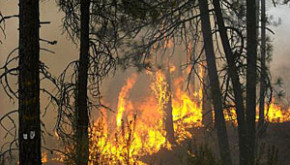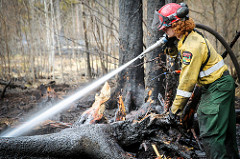
I hope most of you don’t need to read this but we need to talk about what to do if you had fire on your property in 2015. Normally, taxpayers are only able to recover their investment in timber at the time of a harvest. This is done through the use of depletion. However, if you have a loss on your property, you can also reclaim some of that investment in the form of a casualty loss deduction.
The Internal Revenue Code considers any event that is sudden, unusual and unexpected to be in the casualty loss category. Fire, ice, tornado, and hurricanes all fit that description. The sudden part of the definition is talking about the loss in value. The timber must experience a very sudden drop in value not a slow deterioration. If your trees die or suffer a deformity due to insects or disease, that loss would not meet the standard for a casualty loss due to the slow nature of the loss in value.
If you meet the definition of a casualty loss, the next step is figuring out the amount of the loss. Tax law allows you to take a deduction in the amount of the lower of a) reduction in fair market value or b) your adjusted basis in the single identifiable property (SIP). For those of you who have established basis accounts for your timber, the SIP will align with those accounts. For example, if you have a tract of 40 acres and you have a basis account for the land and one for the timber, that is your SIP. If you haven’t set up basis accounts for your timber yet, that can be done retroactively but make sure you have a defensible logic behind how you set it up. The IRS is aware that taxpayers may retroactively set up the account to take advantage of a large SIP.
I alluded to having a large SIP and that being an advantage. If you have a large unit and lose timber on only a small portion of it, you will most likely be able to claim the entire loss. Remember the limitation is change in fair market value or your adjusted basis (whichever is lower). The larger the unit, the more basis available. There are problems with using a large unit though. In an audit situation, it will be necessary to show how fair market value was determined before and after the casualty event. This will require good records and/or an appraisal, both of which will have a cost attached to it.
In addition to calculating the dollar value of the loss, you must account for any insurance proceeds or salvage received. It is possible that you end up with a taxable gain due to salvage. The gain may be postponed if qualified replacement property is acquired within two years. Make sure to keep records related to the casualty event. It is important to show what the event was that caused your loss, when it occurred that the loss was directly related to the event and whether you made any claims for reimbursement or salvage attempts.
If you were the victim of a casualty event, make sure you contact a forester. The forester can be helpful in determining your options on the property going forward including whether or not to salvage. You may also need the assistance of a forester in determining your fair market value before the loss. An accountant can help you with determining what your loss limitation is for the event and assist you in filing the return. While none of this erases the frustration associated with the loss, hopefully it can help you recover some of your loss.
*Disclaimer: These comments are general in nature for your awareness; your facts and circumstances may require different tax treatment.


